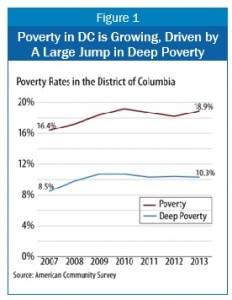While the District’s economy may appear to be strongly recovering from the recession, a look below the surface reveals a much more troubling trend: the number of people living in poverty has risen by more than 25 percent since 2007. The rise is driven largely by a sharp jump in the number of people living in deep poverty, or on less than $12,000 a year for a family of four.
At the same time, the data show a significant rise in the income for the typical DC household. In 2013, median household income was $68,000, a $6,500 increase since the start of the recession. Incomes are also rising for higher-income households. The rise in poverty amidst income gains for others reveals that DC’s economic recovery isn’t reaching a growing number of DC residents. This disparity largely reflects falling wages and a scarcity of jobs for residents without a college degree, which are making it harder for many residents to maintain the foothold in the District.
Several groups of residents are being left out of the District’s economic recovery. Black residents, residents without a college degree and residents living in the Northern and Eastern parts of the District faced significant jumps in poverty since 2007. And only White, non-Hispanic residents have seen income gains since the recession.
The following analysis highlights findings on poverty and income trends from the U.S. Census Bureau’s American Community Survey.
Poverty Is On the Rise for Many DC Residents
In 2013, approximately 115,550 DC residents, or 18.9 percent of the population, lived below the poverty line, or on less than $24,000 a year for a family of four. This represents a 25 percent increase in the number of people living in poverty since 2007. Just over 29,700 children, or 27.2 percent of all children in DC, lived below poverty in 2013, a number that was not statistically different from 2007.
The sharp jump in poverty is largely driven by a significant rise in the number of people living in deep poverty. In 2013, one in 10 DC residents lived below half of the poverty line, or less than $12,000 a year. The large rise in people living in deep poverty accounts for more than two-thirds of the increase in the overall number of people living in poverty.
The new data also show that the increases in poverty are being disproportionately felt by some groups of residents.
- In 2013, 29 percent of Black residents, 13 percent of Latino residents, and 8 percent of White residents lived below the poverty line. The poverty rate for Black residents has grown faster since 2007 than the overall poverty rate. Poverty rates for Latino and White residents were not statistically different from 2007.
- More residents without a college degree are facing higher poverty rates as well. Nearly 40 percent of residents without a high school diploma and 27 percent of residents with a high school diploma lived below the poverty line in 2013. At the same time, 17 percent of residents with some college and just 5 percent of residents with a bachelor’s degree or higher lived in poverty.
Residents with a high school diploma or less saw a more than a 30 percent increase in poverty since 2007. Poverty rates for those with some college or a bachelor’s degree or higher were not statistically different from 2007.
- Poverty changes have also disproportionately impacted certain areas of the District. The Census breaks down the District into five areas that roughly correspond to some ward boundaries, but do have significant overlap among wards (click here for a map that compares the Ward and public use microdata areas (PUMA) boundaries).[1]
Poverty rose the most in an area largely comprised of northeast DC. There, poverty has risen to 19 percent, an astonishing 50 percent increase since 2007. Poverty rates continue to remain highest in an area that largely encompasses Wards 7 and 8 in DC where more than one in three residents lived in poverty in 2013. This represents a 25 percent increase in poverty since 2007. Poverty has fallen by the greatest amount in an area largely comprised of the center part of the District. There, poverty fell to 16 percent in 2013, a drop of nearly one-third since 2007.
To read the complete report, click here.
[1] Available at: http://www.neighborhoodinfodc.org/pdfs/ward_PUMA.pdf.
